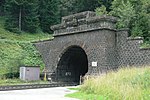Tauern Railway
Ankogel GroupGoldberg GroupRailway lines in Austria

The Tauern Railway (German: Tauernbahn) is an Austrian railway line between Schwarzach-Sankt Veit in the state of Salzburg and Spittal an der Drau in Carinthia. It is part of one of the most important north-south trunk routes (Magistrale) in Europe and also carries tourist traffic for the Gastein Valley. The standard gauge railway line is 79 km (49 mi) long and climbs the High Tauern range of the Central Eastern Alps with a maximum incline of 2.5%, crossing the Alpine crest through the 8,371 m (27,464 ft) long Tauern Tunnel. It is one of the highest standard gauge railways in Europe and the third highest in Austria.
Excerpt from the Wikipedia article Tauern Railway (License: CC BY-SA 3.0, Authors, Images).Tauern Railway
Radeckweg,
Geographical coordinates (GPS) Address Nearby Places Show on map
Geographical coordinates (GPS)
| Latitude | Longitude |
|---|---|
| N 47.0703 ° | E 13.1391 ° |
Address
Radeckweg
Radeckweg
5640 , Böckstein
Salzburg, Austria
Open on Google Maps










